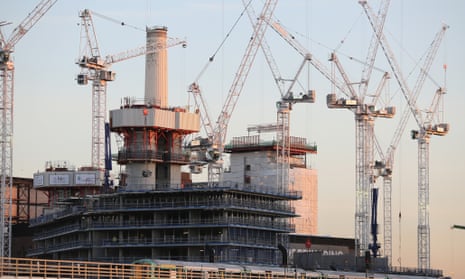In the past, major town and city developments such as London’s King’s Cross or Battersea Park would have been all about giving economic impetus to an area. Projects were measured in terms of financial gain and yield, and considerations around quality of life were seen as a desirable add-on, rather than a fundamental requirement.
But times are changing. Participants at a Guardian roundtable sponsored by engineering and design consultancy Atkins were told that paying attention to the social aspects of an urban development – from housing to health, from fitness to feel-good, from carbon footprint to common space – is becoming central to the way a project is designed.
The question, given that about half of the world’s population – 3.5 billion – already live in cities, a figure that’s predicted to rise to 75% of the population by 2050, is whether sufficient attention is being paid to the social infrastructure of new developments in Britain’s towns and cities, and if not, what needs to be done to move it up the agenda?

“We have to ask whether we are putting enough thought into health, livelihood, the environment and so on,” said Mike McNicholas of Atkins. “In places where the demographics change very quickly, how do we anticipate it and how do we plan for it?” Cities, he said, were as much about social gain as economic gain, but the emphasis had historically been all about the latter.
Participants at the roundtable heard that although there are examples of good practice in putting quality of life issues at the heart of Britain’s new builds and new developments, various fundamentals still need to be addressed to ensure that opportunities are not missed. “One thing we don’t want,” said Sally Prentice, a member of Lambeth’s planning committee in south London, “is to look back in 20 years and realise we missed an opportunity.”
Prentice was talking specifically about the major development under way at Battersea Power Station. The bulk of the £8bn project is being funded by a Malaysian private developer, and Prentice fears that not enough is being done to provide social infrastructure there. For example, she said, only a “tiny amount” of affordable housing has been included in the plans.

“What you are going to see is a lot of buy to let, second homes and property owned abroad; lots of very luxurious accommodation. And another big shopping centre. You have to ask yourself whether this is what London really needs.”
Prentice conceded that the development would include a library and a primary school, but said this did not negate her concerns. In 20 years’ time, she fears, it will become clear that more public investment would have yielded more community outcomes.
Worries over the affordability of the housing at Battersea Power Station are widespread. At the end of last year the Guardian reported that a flat in the development, initially sold for £1m, was back on the market a few months later with a £1.5m price tag – despite the fact that it still hadn’t been built.
But mayor of London Boris Johnson has defended the development, saying there will be 600 affordable homes on the site, which is “better than nothing”.
At the heart of the roundtable debate is the dilemma that although private funding is often needed to spearhead major new developments, it is public investment that has traditionally injected the “community” element into them.
Most of the major projects in London are being funded by private sector money, said Bob Allies, partner in Allies and Morrison, citing King’s Cross and Earls Court as well as the Battersea Power Station redevelopment. There was no doubt, he said, of the benefits of this shift, but because private developers need to take public sector requirements into account, there is a danger of too much of a social infrastructure burden being placed on them.
Injecting social infrastructure into a development was, said Allies, “a complicated dynamic” that required an unusual skill set. His company was behind the redesign of King’s Cross which, he said, seemed to be working well. “But if you look at our planning application, Central Saint Martins [art school] wasn’t in it and at that stage no one knew it was going to be there. We didn’t know that was going to happen. So it’s not all to do with physical planning. It’s also about having clever developers who have their ears open for new directions.”

Getting it right brings its own dangers: specifically, the risk of pricing people out of the housing market when an area is turned around. Alison Butler, deputy leader of the London Borough of Croydon, south London, said: “If you look at an area like Brixton, which is now very desirable and successful, you see that people can’t afford to live there any more, so they move further out. Areas like mine need enough houses for these people. And we need to ensure that outer London boroughs don’t become ghettoes for inner-London areas.”
According to Neil Pennell, head of sustainability and engineering at the Land Securities Group, the key is for private developers to have good dialogue with the local authorities. “Authorities have a vision of what they want within the community and organisations like us have got to make economic choices. When we are making investments we need to have an active dialogue, so we can work out the best way forward.” Pennell gave the example of Oxford, where his company is part of a major scheme to provide a new shopping centre. “They very much want to be an exemplary green city, so the challenge is to create a sustainable solution,” he said.
While communities have to be properly invested in town and city developments, one speaker said it was naive to think that “talking to people” was all that was required. It was clear, said Martin Summersgill of Imperial College London, that all neighbourhoods were not equal when it came to their ability to articulate what they wanted. Dialogue with neighbourhood forums, he said, yielded mixed results: “Some work well and others are a damp squib.”

Population size is a crucial factor in making cities “work”, the roundtable heard. David Leam of London First said the big challenge for the capital was how to make it both bigger and better. “If we want London to remain a successful leading world community that brings big benefits to the whole country then quality of life really matters,” he said.
One of Summersgill’s concerns was that those European cities that were most often cited as boasting the best social infrastructure and quality of life were much smaller than London – cities such as Copenhagen and Malmo, for example, have about 2 or 3 million people, compared with the 8 million (and growing) population of London.
But then again, said Allies, the whole issue of density of population had changed. In the past it was seen as a negative factor, “but today the closer we live the less carbon we use, the more efficient our transport and the more viable our arts centres and theatres”, he said. Ron Moir of Balfour Beatty Construction said that the big issue around density was working out the “right” level – who, he asked, was in a position to set that?
Measuring social value is also problematic. What is needed, said Moir, is a London standard that developers are required to satisfy. Adding social value, such as affordable housing, open spaces, facilities for cross-generational communities and so on, were good for business as well as giving a good vibe to a neighbourhood. Developers, said Summersgill, have realised that and “want to stop being the bad guys”.
Others agreed. “I’m very optimistic for British cities,” said Leam. “In cities such as London and Manchester there are improved communities where the public and private sectors have worked well together.” That proves it can be done, he said – and it will have to be done more often in the future.
On the panel
Oliver Balch Chair, journalist
Gorka Espiau Director of innovation for Cities and Regions, The Young Foundation
Alison Butler Deputy leader, London borough of Croydon
Mike McNicholas MD, design and engineering, Atkins
Bob Allies Partner, Allies and Morrison
Andrew Carter CEO, Centre for Cities
Amanda Coyle Director of health and communities, Greater London Authority
Ron Moir Director of design, Balfour Beatty Construction
Sally Prentice Member of planning committee, London borough of Lambeth
Prof Tim Broyd Chair, in built environment foresight, University College London
David Leam Executive director of policy, London First
Neil Pennell Head of sustainability and engineering, Land Securities Group
Martin Summersgill Director, estates masterplanning and development, Imperial College London
